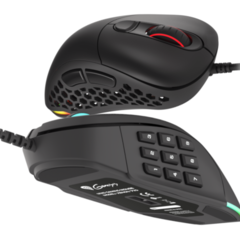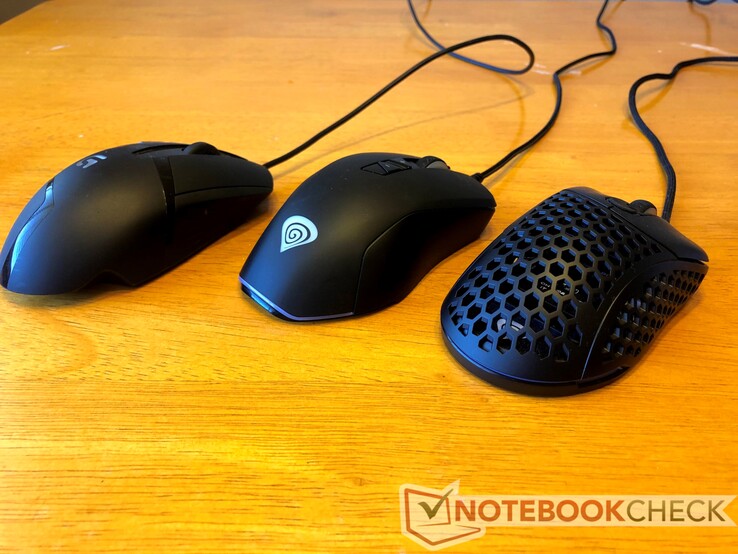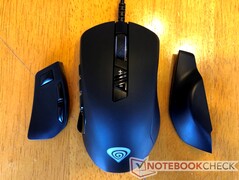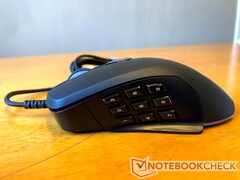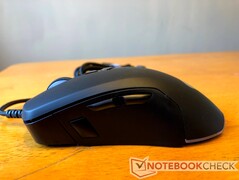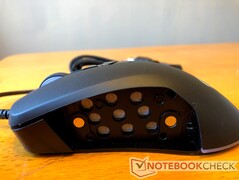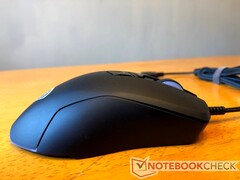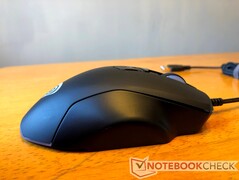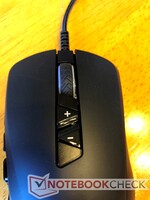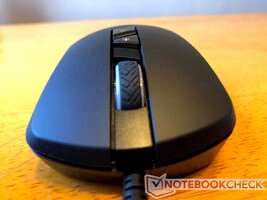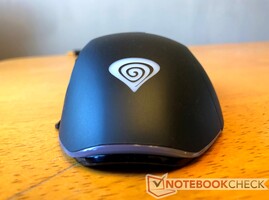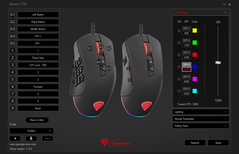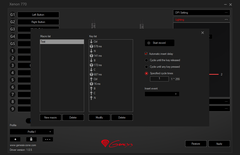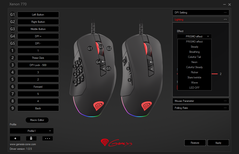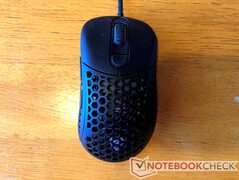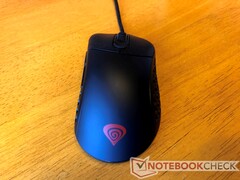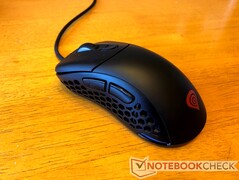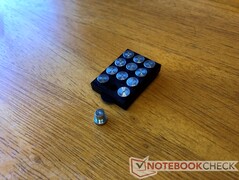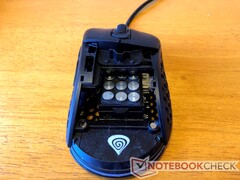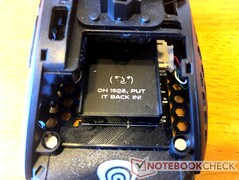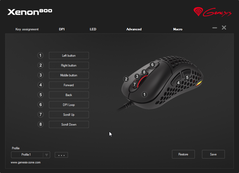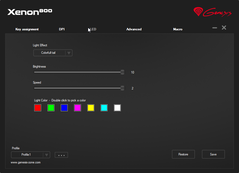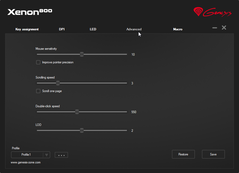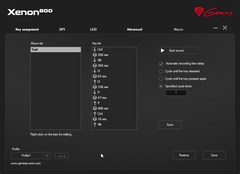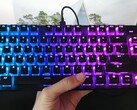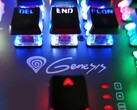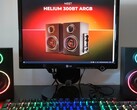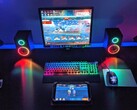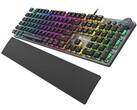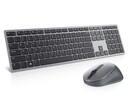Genesis, a peripheral manufacturer and retailer based out of Poland, has made inroads with the gaming community over the past few years. We've covered a few devices from Genesis before, namely the Thor 420 RGB low-profile mechanical keyboard and the RX85 RGB full-sized mechanical keyboard. Today's hands-on takes a different slant.
Genesis sent me the Xenon 800 Ultralight and Xenon 770 Hybrid gaming mice for review. I've been using the mice on different systems for the past three months. My daily driver is a Logitech G502 Proteus Core gaming mouse. I also own the Logitech G402 Hyperion Fury and G602 wireless gaming mouse. The G402 is close to the Xenon 800 and Xenon 770's respective prices, both of which hover around the US$40 mark, so I'll use the Hyperion Fury as a baseline for comparison.
Xenon 770 Hybrid
Design and feel
At 12.8 x 6.9 x 3.9 cm (L x W x H), the Xenon 770 Hybrid is fairly large (roughly as big as the G402). The 770's length makes it well-suited for palm grip. I have large hands, and my palm rests comfortably on the body of the mouse when relaxed. The left- and right-click buttons fall directly under the pointer and middle fingers in this grip with a small bit of extra length. The scroll wheel is perfectly positioned here too, though the DPI adjustment buttons are set far back enough to cause a bit of cramped curling in my middle finger to use.
The main gimmick of the 770 Hybrid is its swappable side plates. Genesis includes a standard side plate with very clicky and responsive Back, Forward, and center buttons (often used as a "sniper" or find tracking button). This can be switched with a side panel containing nine programmable buttons. These buttons have the same excellent response and clicky feel as the other panel's, but they are cramped together. It took me quite some time (several weeks of regular use) to consistently click the macro button I intended. After this bit of training, I can now use these buttons reliably, but the buttons toward the rear of the panel take some effort to hit.
The right side of the mouse can be set with a convex panel or one that has a slight bump designed to be a finger rest. The panels are held in place with two magnets each and sit flush with the chassis. Small notches on their bottom side allow users to pull the panels off. They stay securely in place during normal use.
The Xenon 770 has a tightly braided cable that feels on par with high-end mice like the Logitech G502 Proteus Core's cable. Over my two months with the mouse, the cable has yet to fray. One downside is that there is no built-in strap, so the cable is hard to wrangle. However, it doesn't snag or pull the mouse. The Xenon 770 connects via a USB-A port.
Since this is a gaming mouse, there are some RGB zones. The scroll wheel, Genesis logo on palm rest, and a strip along the bottom of the rear of the mouse all sport RGB lighting. These zones can be set to a variety of colors in software, and the rear strip can shift through the rainbow, pulse, or run through several other effects.
The bottom of the mouse is uneventful. Thin plastic feet run across the front and rear corners of the underside. These can be replaced, but they are difficult to remove. The feet are very smooth and make for easy gliding.
The main chassis of the Xenon 770 is covered with textured plastic. The side panels and front of the mouse are smooth plastic. The build quality is adequate; while the Xenon 770 feels much better than cheap plastic mice, it lacks the robust quality of higher-end mice like the G402 and G502, both of which are also made of plastic.
Specifications, performance, and software
Genesis equips the Xenon 770 Hybrid with a PixArt PAW3327 optical sensor. The sensor scales between 200 and 10,200 DPI, so most gamers should find a sensitivity setting to their liking. The dedicated DPI buttons shift through six preset resolutions on the fly. Users can fine-tune the sensitivity and configure the preset slots in the Genesis software suite.
The Xenon 770 uses Huano switches, which are rated at up to 20 million clicks. I can't find any fault with the clicking mechanism. Every click registers, even when I'm rapidly hitting the left-click in firefights. The mechanism feels solid. The switches are better than the G402's, which feel loose and mushy in comparison.
The Xenon 770 has a polling rate of 1000 Hz. In my testing, the mouse easily hits this number. Genesis also rates the mouse at "8000 FPS," so it should easily keep up even with professional gamers. The mouse's acceleration is 30 G and it has a maximum tracking speed of 220 inches per second, according to Genesis.
For my daily use, the mouse is excellent. As an everyday mouse, there's no cause for complaint. I regularly play RTS (Age of Empires 2), stealth (Hitman), and first-person shooter games (Counter-Strike: GO, DOOM). I'm by no means at the professional level, but I have felt held back by regular off-the-shelf mice. The Xenon 770 feels great in games. I can't blame missed shots on the mouse; it's accurate and aims the cursor exactly where I want it. The macro button panel is also extremely useful in AoE2; I have several hotkeys bound to these buttons, and they are a help. I will say I only use the first two rows (buttons 1-6) as the last row is set too far back for me to comfortably hit. As I mentioned, the small buttons also took me a while to adjust. Now that I'm trained on them, they're a help rather than a novelty or hindrance.
The Xenon 770's software tool (available for download from Genesis' website) is quite powerful. Every button, including the scroll wheel click and DPI adjustment buttons, can be rebound. Users can also record and manually edit their own macros and assign these to a button. Lighting options for the rear strip are controlled through the options here, as are mouse parameters like scroll speed and polling rate. In sum, the software is simple, straightforward, and powerful.
The Xenon 770 has onboard memory, which stores key bindings, profiles, mouse settings, lighting options, and other settings accessible through the software tool.
Xenon 800 Lightweight
Design and Feel
In contrast to the larger Xenon 770 Hybrid, the Xenon 800 Lightweight feels noticeably smaller. At 12.0 x 6.6 x 4.3 cm (L x W x H), it's not much smaller on paper than the Xenon 770. However, it's higher arch and wider body make the mouse feel minuscule in comparison. I have to use a claw grip to comfortably handle the Xenon 800; in a palm grip, my knuckles end up at the very rear of the mouse and my palm ends up over my desk. While I prefer a palm grip, using a claw grip on the Xenon 800 isn't uncomfortable due to its high arch.
If the design of the mouse looks familiar, it's because it shares the chassis (and many other components) with the Sharkoon Light2 100 we reviewed back in July. The Xenon 800 essentially is the Sharkoon Light2 100 with some changes. It has the same shape as the Sharkoon, the same cloth braided cable (that similarly frays after a month of regular use), the same polling rate switch on the bottom that switches the polling rate between 125, 500, and 1000 Hz, and the same Omron switches rated at 20 million clicks. However, Genesis has made some significant modifications.
Most noticeably, the Xenon 800's chassis is perforated with a honeycomb pattern. This reduces its weight to a mere 58 grams while maintaining structural rigidity. The mouse feels incredibly light, but the plastic feels sturdy and doesn't flex when pressure is applied. I can grip the Xenon 800 tightly without worrying about the shell deforming or cracking. The top panel can be replaced with a solid piece. This increases the weight very slightly, but I can't notice it when using the mouse.
The programmable side buttons don't feel as nice as those on the Xenon 770. They're mushy, and there's a lot of give before the button actually clicks. The result is that they feel somewhat cheap, but they reliably register clicks.
Genesis includes a small tray with 12 tiny weights, allowing users to adjust the weight from 58 to 79 grams. This tray fits into a small shelf inside the mouse, which can be accessed by removing the top panel. The weight tray is securely held by weak magnets; I couldn't dislodge it even by shaking the mouse upside down.
Genesis also includes small caps for the side buttons and the rubber DPI switch, which sits behind the scroll wheel. In contrast to the Xenon 770's two DPI switches, which allow users to navigate forward and backward through DPI profiles, the Xenon 800 has a single DPI switch. It only cycles one way through the seven DPI profiles, so users may have to click through all their profiles to get to the one they want. This switch cycles through up to seven profiles.
The mouse's feet are made of Teflon, just like those on the Xenon 770. They are smooth and glide over surfaces without any turbulence. They can be swapped out, but it's somewhat difficult.
All said, the Xenon 800 is a well-built lightweight mouse. Other lightweight mice I've used felt thin and fragile. That's not the case here. The Xenon 800 tricks my mind with its lightweight construction; I am still surprised at how strong the chassis feels compared to its weight.
Specifications, performance, and software
As mentioned, the Xenon 800 uses Omron switches which are rated for 20 million clicks. The switches are responsive, but they feel a bit flimsier than those used in the Xenon 770. Still, I didn't find much to complain about during gameplay. They can keep up with my manic clicking during intense firefights or battles.
The Xenon 800 uses a PixArt PMW 3389 optical sensor that scales up to an astounding 16,000 DPI. The mouse's polling rate goes up to 1000 Hz. Its maximum tracking speed is 400 inches/second, and acceleration is rated at 50 G.
At its maximum DPI setting, the mouse is extremely sensitive. However, tracking stops on a dime, and there isn't any cursor drift to speak of. If you need a fast mouse, this one should be at the top of your list. The sensor tracks unbelievably quickly without sacrificing accuracy and precision.
The software tool for the Xenon 800 is robust but less fluid than the tool for the Xenon 770. Still, every option users could want is here: DPI profile setup, RGB lighting control, macro creation, and more. Like the Xenon 770, the Xenon 800 has onboard storage so users can save the settings they configure in software.
Conclusion
Genesis has hit it out of the park not once, but twice here. The Xenon 770 and Xenon 800 compete very well against other mice in their particular markets.
The interchangeable plates on the Xenon 770 are well-executed. I'd like to see slightly larger buttons with a more thoughtful layout, primarily setting the buttons closer to the front of the mouse to prevent strain when reaching for the back row. Otherwise, every other aspect of the mouse is excellent. Its build quality isn't quite up to scratch when compared to heavy hitters from Logitech, Corsair, Steel Series, and others, but compared to other $40 gaming mice, the Xenon 770 meets or exceeds expectations.
The Xenon 800 is more of a niche device. I'm personally not a fan of lightweight mice (mostly because they tend to feel thin and cheap), but I have little complaint with the Xenon 800. It's unbelievably light but retains a reasonably solid build. The optical sensor is excellent and extremely precise. The biggest sticking points for me are the mushy side buttons and the cloth cable, which started to fray after the first month of use.
To sum up, if you're looking for an MMO or MOBO mouse (or a mouse with lots of flexibility and macro options), then the Xenon 770 is an excellent choice. For $40, it's a fair bit less expensive than other prominent players in this sector. If you need a lightweight mouse, check out the Xenon 800 as well. Its optical sensor is fantastic, and its build quality is a step ahead of other lightweight mice.
The Genesis Xenon 770 and Genesis 800 can both be purchased from various online retailers, depending on your region.
Disclaimer: The author of this review received the Xenon 770 Hybrid Gaming Mouse and Xenon 800 Lightweight Gaming Mouse from Genesis free of charge for the purpose of testing.


